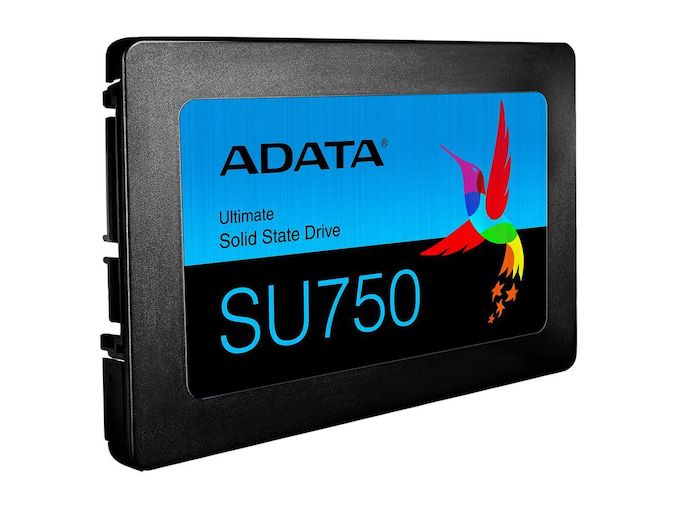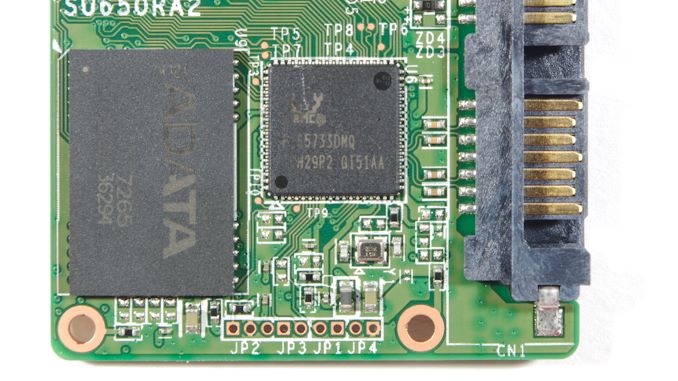The ADATA Ultimate SU750 1TB SSD Review: Realtek Does Storage, Part 1
by Billy Tallis on December 6, 2019 8:00 AM EST
Realtek may only be a household name for particularly nerdy families, but their chips are everywhere in the PC industry. They are best known for their near-ubiquitous audio codecs and for their networking chips. Their products are usually not known as the absolute best quality that money can buy, but they consistently offer "good enough" performance and feature sets combined with very affordable pricing that wins over OEMs and gets Realtek devices in the hands of any consumer that isn't deliberately avoiding them.
In recent years, Realtek has set their sights on the SSD market. Some of their earliest attempts to make SSD controllers were more or less failures (eg. a 55nm NVMe controller that could barely break 1GB/s), but they now have a full lineup of controllers are ready to compete in almost every market segment. This is where ADATA comes in; we can usually count on them to try out all the SSD controllers and NAND options available. They end up shipping more of those experiments than is really sensible, and that contributes to their confusingly broad product lineup. However, they are more judicious with their review sampling, which is why we're looking at Realtek's second-generation SSD controllers.
We're starting our look into ADATA's Realtek-based SSDs at the low end of the product stack, with the ADATA Ultimate SU750, a DRAMless SATA SSD using the RTS5733 controller and 3D TLC NAND. This drive is also being sold as the Amazon-exclusive ADATA SU760.
The RTS5733 controller is a mere two-channel design, which puts it in the same league as controllers like the Phison S11, used in a variety of budget SATA drives. Quite a few other budget drives use Silicon Motion 4-channel controllers like the SM2258XT, and they don't seem to have any trouble competing on cost with drives using smaller 2-channel controllers.
Part of Realtek's overall SSD controller strategy is an emphasis on reducing the need for external DRAM on the SSD; the performance penalties that come from having little or no DRAM are partially offset by including larger buffers on the controller itself, but the precise amount has not been disclosed.
| ADATA Ultimate SU750 SSD Specifications | |||||
| Capacity | 256 GB | 512 GB | 1 TB | ||
| Form Factor | 2.5" SATA | ||||
| Controller | Realtek RTS5733DMQ | ||||
| DRAM | None | ||||
| NAND Flash | Micron 64L 3D TLC | ||||
| Sequential Read | 550 MB/s | ||||
| Sequential Write | 520 MB/s | ||||
| Random Read | 65k IOPS | ||||
| Random Write | 75k IOPS | ||||
| Warranty | 3 years | ||||
| Write Endurance | 200 TB 0.7 DWPD |
400 TB 0.7 DWPD |
800 TB 0.7 DWPD |
||
| Current Retail Price | $31.99 (12¢/GB) |
$51.99 (10¢/GB) |
$94.99 (9¢/GB) |
||
The ADATA SU750 uses Micron 64L 3D TLC NAND flash memory, the same as most of ADATA's current SSD models. ADATA does their own binning and packaging of NAND, and it appears that the SU750 gets pretty good quality flash: the write endurance ratings are roughly 0.7 drive writes per day for the 3-year warranty period, equivalent to about 0.4 DWPD over 5 years. This is slightly higher endurance than quite a few of ADATA's own SSDs that come with 5-year warranties. If anything, we usually expect DRAMless SSDs to get lower endurance ratings due to less effective wear leveling.
The use of a DRAMless, two-channel controller doesn't hurt the sequential IO specs for the SU750, but it does lead ADATA to give it lower random IO performance ratings than mainstream drives that can saturate the SATA link. The random read performance takes the bigger hit, which is normal for DRAMless drives.
The construction of the SU750 is typical for a low-end SATA drive. The case is half metal, half plastic, and held together with clips rather than screws. The PCB inside takes up only a third of the available space. The bulk of that PCB space is taken up by two NAND packages on each side, containing 256GB each for our 1TB sample. The two-channel DRAMless controller itself has a fairly low pin count and consequently small footprint.
The Competition
We don't get really low-end SSD samples very often, but we do have the Toshiba TR200 as a representative of the many drives that use the Phison S11 controller with Toshiba NAND. We also have the Samsung 860 QVO, a QLC-based SSD that belongs in this entry-level segment even if Samsung refuses to price it accordingly. Also of note is the ADATA SU800, an older model with Micron 32-layer 3D TLC that is slower and cheaper than current mainstream SATA drives, but usually outperforms any DRAMless SATA drive thanks to the SU800's DRAM buffer. (Note that the largest SU800 we have is the 512GB model, so it's at a potential disadvantage to the 1TB SU750.) The rest of the drives we are comparing the SU750 to are in higher tiers, though the price differences between mainstream SATA drives and an entry-level model like the SU750 can be all but erased by a good sale.
The Crucial BX500 and Mushkin Source are similar DRAMless SATA drives in direct competition with the SU750. We've tested a smaller capacity of the Source, but have not tested the BX500.
| AnandTech 2018 Consumer SSD Testbed | |
| CPU | Intel Xeon E3 1240 v5 |
| Motherboard | ASRock Fatal1ty E3V5 Performance Gaming/OC |
| Chipset | Intel C232 |
| Memory | 4x 8GB G.SKILL Ripjaws DDR4-2400 CL15 |
| Graphics | AMD Radeon HD 5450, 1920x1200@60Hz |
| Software | Windows 10 x64, version 1709 |
| Linux kernel version 4.14, fio version 3.6 | |
| Spectre/Meltdown microcode and OS patches current as of May 2018 | |
- Thanks to Intel for the Xeon E3 1240 v5 CPU
- Thanks to ASRock for the E3V5 Performance Gaming/OC
- Thanks to G.SKILL for the Ripjaws DDR4-2400 RAM
- Thanks to Corsair for the RM750 power supply, Carbide 200R case, and Hydro H60 CPU cooler
- Thanks to Quarch for the HD Programmable Power Module and accessories
- Thanks to StarTech for providing a RK2236BKF 22U rack cabinet.














54 Comments
View All Comments
sonny73n - Friday, December 6, 2019 - link
Realtek does audioRealtek does networking
Realtek does storage
Debbie does Dallas
RadiclDreamer - Friday, December 6, 2019 - link
Realtek may do all of these things, but it does them all poorly.FunBunny2 - Friday, December 6, 2019 - link
"Realtek may do all of these things, but it does them all poorly."Debbie wasn't so hot either. :):)
boozed - Friday, December 6, 2019 - link
I don't know that I'd call them poor. Good value, reliable (in my experience) and good enough for the vast majority of users.Other options are available for enthusiasts.
eek2121 - Friday, December 6, 2019 - link
The trouble is that you are talking about a few dollars for a much faster and more power efficient drive. This controller appears DOA as it brings nothing unique to the table.Samus - Saturday, December 7, 2019 - link
With what Intel charges for network controllers, it’s astonishing Realtek is in business when you consider how superior an Intel NIC is while being a few dollars more. And wireless is a whole different story. I’d put Realtek at the absolute bottom of the list. Atheros/Qualcomm, Intel, Agere, Lucent, Broadcom, all have better reliability, support (which is shocking when you consider how vastly used Realtek products are) and generally - performance, than competing Realtek solutions.I think where Realtek scores is availability. Their volume shows commitment to OEM’s that require dependable shipping schedules. This can be as important is BOM pricing, and when you look at the numbers, it seems (and I’m speculating) Realtek designs products for volume production more than anything else. The incredibly low pin count and a 2 channel controller back this up. We are talking about possibly the most basic SATA SSD controller in production and that means they will be able to make a shitload of them really fast really cheap.
And unfortunately OEMs will bite because they know 90% of the people buying this crap don’t care about the inner margin performance of an SSD. Most people buy on price, reliability and warranty.
This shitty SSD May have all 3 bases covered considering the quality binning of Micron NAND.
close - Saturday, December 7, 2019 - link
"a few dollars more" adds up when buying by the truckload. With millions of devices that have a network chipset that's quite some money.jabber - Sunday, December 8, 2019 - link
Yeah amazing how many people don't realise how shaving just 50 cents off a product that will sell hundreds of thousands to millions will save a company a fortune and help with profit.A good example is to watch the documentary "Building a Faster Horse" on how Ford designed and built the 2016 iirc Ford Mustang. Every single part and component was scrutinised to see if it could be either removed/simplified or made cheaper.
That's why Realtek exists still. Their parts are 50c cheaper than Intels.
Manch - Monday, December 9, 2019 - link
Ford been making the Mustang cheaper and cheaper while charging more and more. Started with the Getrag MT-82 grenade and got worse with the crap IRS, corner cutting everywhere. Add on top of it a horrid design (Looks like a 2 door Focus) and they wonder why they're losing customers.hanselltc - Saturday, December 7, 2019 - link
Killer